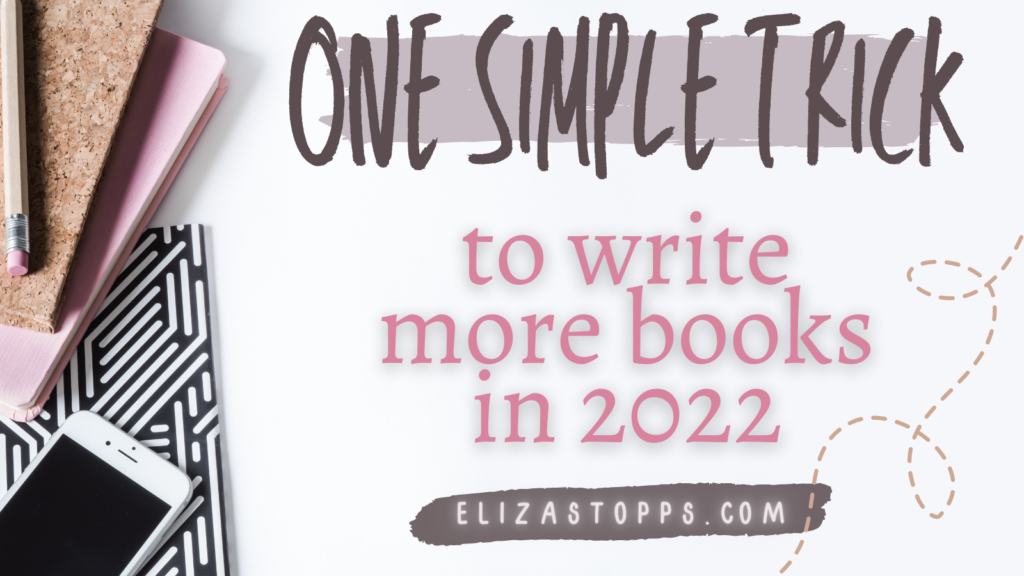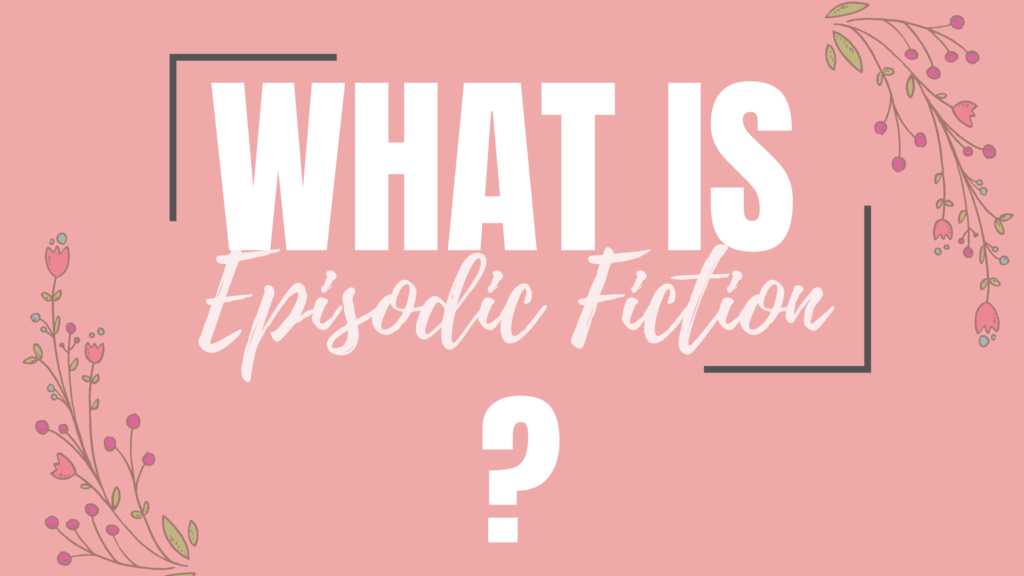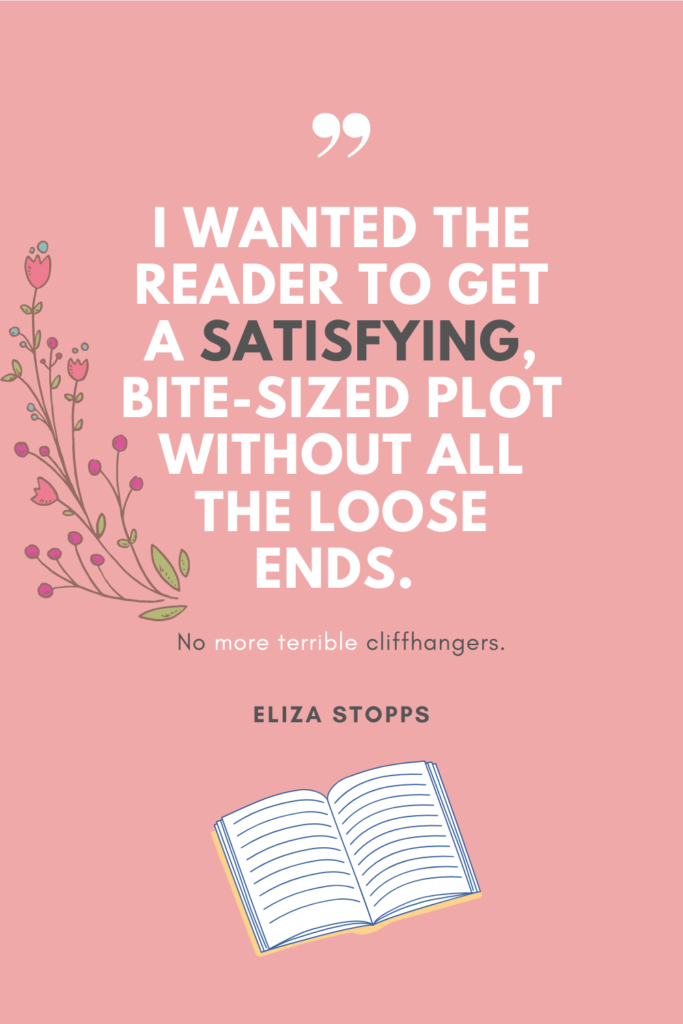Please note that any links within this post may be affiliate links. This means I earn a commission on qualifying sales at no extra cost to you.
One Simple Trick to Write More Books in 2022
Sorry for the clickbait title! But I truly do think that this one trick can help any writer who wants to write more books this year. Maybe you want to finish the sprawling fantasy series that you started or you need to find the courage to write the next book after your debut was a flop. In this post, I will share one simple clickbaity trick that helped me go from releasing one book a year (approximately) to releasing three novels in 2022.
It can seem overwhelming to write multiple novels a year, and for those just beginning to follow the 20 books to 50k lifestyle, writing twenty novels feels impossible. Now, I can’t say that I’m advocating for whether 20 books to 50k is legitimate, since I have not yet written that many, but it seems like a good goal. I’m currently at 9 books (under multiple pen names) and this is the first year that I’m able to actually turn a profit on my writing. (For those wondering, I published my first book back in 2017.)
So, how did I go from writing four books over a four year period to releasing three books in a year? Episodic fiction.

Write Episodic Fiction
The biggest thing that changed for me in 2021 and 2022 is that I started writing more episodic fiction. Now, this blog post is actually an update of one that I wrote in January of 2021, but my true start in episodic fiction was back when I published my first book, Mythical Investigations, in 2017. I mention the dates because it is important to see how long it took me to get here and how writing books in an episodic way actually sped things up immensly.
Episodic fiction for me, at that time, meant writing each novella as an episode of a show. Here’s what I had to say about episodic fiction back last year:
The way I chose to write episodic fiction was as if each serial was an episode of a television show. I want to be specific that I was not writing a script (I wouldn’t even know how to.) I wanted the books to be brief but submersible. I wanted them to invite you into the world and help you to see each “episode.”There is world-building, but the reader is thrust into the story without a lot of preparation. You’re expected to trust the experience and have an open mind. All the explanations will happen in due time, but right now, we’re focusing on the action.
I am in the process of writing a science/fantasy serial set on the distant planet of Kapaton. I’ve published four, with one more in the works. My protagonist, Leslie Kim, is thrust into a variety of situations with other characters, fantasy creatures, and physical and moral challenges. I write each edition in the serial to feel like an episode of television. I want to cut the fat, get to the story, and save the readers a little time.
I did not want it to be like a short story.I wanted the reader to get a satisfying, bite-sized plot without all the loose ends. Each episode needed to have a connecting, over-arching story while still able to stand on its own. This is difficult to achieve because I did not want to spend a great deal of the words I had limited myself to, describing the planet and the aliens who occupy it.
In 2021, I started writing for Kindle Vella. This is a mobile-first serialized format where you release one episode (what they call chapters) at a time. You earn bonuses for thumbs ups, follows, and reviews. This was really instrumental for me because it allowed me to publish two books as I wrote them. This also means that I get paid as I write and release the book, which jumps through a couple of hoops. For The Disappearance of Susannah Dane, I was able to use the money that I made releasing the book on Kindle Vella and reinvest it into proofreading, formatting, and designing the book to be released as an eBook and paperback.
For some writers, they cringe at the idea of releasing while they write. This seems intimidating, but I have found it actually produces a higher quality of work. When I write a novel the traditional way, I spit out the rough draft in a few weeks and then spend months writing and rewriting that draft. It takes a very long time and by the time I actually release the book, I am sick of looking at it.
What is Episodic Fiction?

“You start with a character who, for one reason or another, is launched into a situation that involves travel and a series of adventures with different groups of characters and challenges. In the end, the protagonist finds happiness.”
Episodic Novels by Ginny Weinhardt.
Episodic fiction has been described in many ways. I have heard it described as a novel made up of many short, almost unrelated chapters or as serialized content. I chose the quote above from an article that I found when I sat down to write this blog post. I think this is a nice descriptor for an episodic novel, but it could also be a description for any novel. In almost every story you have a main character who faces a challenge and eventually makes their way to happiness.
The Key Element of Episodic Fiction
The key element, which is also mentioned in the article linked above, is that the character does not usually have time to change a great deal in the book. Episodic fiction tends to be brief; it gets to the point. There isn’t the same opportunity for expansive world-building, long explanations of back story, or scenes that don’t move the plot.
Each scene has to move the story forward or the book won’t go anywhere. There isn’t room for wasted words, scenes, or chapters. This makes the experience much quicker to read. It’s more to the point and less frustrating. But there also has to be more of it to be worth the reader’s time.
For The Leslie Kim Serials, this is how I write Leslie Kim. His character development is somewhat the same for each book. He doesn’t change tremendously as a character, though he might change his perspective on the case at hand.
This is true for the Paige Parker Mystery Series on Kindle Vella as well. Paige, as a person, stays true to her core through each book. Since it is young adult book, she does have a lot more character development and I imagine that at the end of the series, she will have changed a lot as a person.
Write, Edit, and Release Weekly
For some writers, they cringe at the idea of releasing while they write. This seems intimidating, but I have found it actually produces a higher quality of work. When I write a novel the traditional way, I spit out the rough draft in a few weeks and then spend months writing and rewriting that draft. It takes a very long time and by the time I actually release the book, I am sick of looking at it.
When I write an episode for Kindle Vella, I am able to slow down the process initially and in turn, speed up the process overall. I release my episodes on Saturday each week. If I haven’t written multiple episodes ahead of time, I know that I have to write and edit the episode during the week. So, I will re-read the last episode and write the next one on Monday. On Wednesday, I will return to it and read the new episode and make any changes. Then I go over it again for proofreading purposes before I release it on Friday (Amazon sometimes takes 24 hours to release, so I always publish a day early to make sure it is there for readers on Saturday morning.)
For The Absence of Aurelia Perez, I started publishing on October 9th and I’ve released 17 episodes. Since I am not consumed by trying to pump out the whole draft in one go, I’m able to catch plot holes and make changes to the story when I realize it isn’t working. I am writing from an outline that I did write first, but I make changes to it as I realize they are necessary. This is great because I can take feedback from readers into consideration and I can take my time with the story craft.
Since I am not rushed, I also have more time to write for clients. I currently work as a freelancer and write non-fiction books, as well as biographies and website content, for clients. I only commit to one Kindle Vella story at a time so that I can fit my schedule with clients around what I know I need to do in the upcoming weeks.
It has also given me more time to work on The Leslie Kim Serials at the same time, instead of devoting one year to my Kindle Vella projects and pushing off the Leslie Kim books for another year.
The Length of Episodic Fiction
In the original version of my post, I had this to say about episodic fiction length:
As a writer, I write neither long nor short. My first book was about 85,000 words. But the vision that I had of this serial was something much briefer. I wanted it to feel accessible to the reader who only has the ability to catch snippets on a lunch break. I knew a lot of people that read before their shift or while they forced down a sandwich. I wanted to craft the story in a way that that person could sit down and finish an entire chapter without losing their place. I wanted to keep them fairly short and the storyline direct.I want the books to be something you can consume within a few hours, maybe on your commute on the bus or
The first vision or idea that I had of Leslie Kim had nothing to do with Kapaton or Grootslangs or even Vampires. The idea was simple, Leslie must face off against some large creature in the water and struggles with whether or not he should kill it. He has a bounty on the line but ultimately decides to spare the creature. As Leslie attempts to release the monster, it turns on him and he is forced to kill it anyway. I did eventually write this as a short story and plan to release it at some point!
That scene stuck with me and I chewed it around in my head for about a year. When I finally sat down to write the serial, I had a strict outline that I wanted to follow. The story evolved many times after this but the rules stayed the same. I wanted each serial to be between 15,000 and 40,000 words.Initially, I wanted there to be only 15 chapters in each book; this changed when I realized that I cared more about keeping the chapters “bite-sized” than I did about the number of chapters.
My opinion on this has evolved a little bit. With The Disappearance of Susannah Dane, each episode is around 1500 words (with some variation between 500 and 3,000 if the episodes seem to need it) and the book ended up being nearly 80,000 words. So, the book itself is novel length, but each chapter is brief and can be read during your lunch hour.
My most recent Leslie Kim book has grown in size as well and will be around 40,000 words when it is released which is closer to “novel” length than “novella.” I really struggled with this for a while because I didn’t want it to seem out of place with the other books, but after editing it, the length is just what it needed to be for the project.
Episodic Fiction is Freedom
In short, writing fiction in an episodic way, whether through short novellas or releasing in the chapters in weekly installments on Wattpad, Kindle Vella, or Radish, allows you to have an element of freedom. You can write and get feedback immediately. You can release more books because you are writing more often, without being consumed by any one project. You can still write long, novel length books and release them in an episodic way, if that feels right for your project.
If you are looking for a way to increase your output in 2022, consider writing episodic fiction!








This is very informative information! Thank you for sharing. I am interested in publishing fiction using Kindle Vella, but I struggle with outlining and structuring episodic fiction. Do you have any posts or blogs related to this for helping would-be Kindle Vella authors?
Thanks,
Bryan
Here are some of my posts about episodic fiction. While I don’t have one specifically for outlining, these posts are all relevant to writing short stories and writing on Kindle Vella. I hope this helps!
Writing Paige Parker Mysteries #3
Character Development Worksheet & A Free Short Story
Author Interview with Kindle Vella Author Celia Shadrach
Q&A with Eliza Stopps about Kindle Vella
My Experience with Kindle Vella
Why I’m Publishing on Kindle Vella